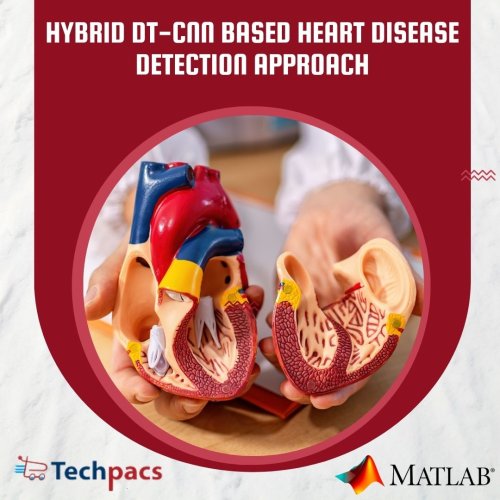Hybrid Relief Feature Selection, Decision Tree, and CNN Model for Heart Disease Prediction.
Problem Definition
Cardiovascular diseases (CVD) have become a major health concern globally, affecting individuals of all ages. Various automated techniques have been proposed by researchers to detect heart disease in patients, but these models have significant limitations that hinder their accuracy and performance. One key limitation is the lack of effective feature selection techniques, leading to increased complexity and processing time. Furthermore, the use of machine learning (ML) or deep learning (DL) classifiers has not yielded satisfactory results when applied to sequential datasets. Additionally, the imbalance of datasets used in existing models has further compromised their accuracy.
It is evident that there is a critical need for a new and efficient heart disease detection system that addresses these limitations to improve accuracy and performance in diagnosing CVD.
Objective
The objective of the proposed project is to address the limitations of current models for detecting cardiovascular diseases (CVD) by implementing a Relief based Feature Selection algorithm and a hybrid model combining deep learning CNN algorithm with a decision tree model. The goal is to improve the accuracy and efficiency of the heart disease prediction model by enhancing feature selection techniques and utilizing a combination of machine learning and deep learning classifiers. This approach involves two main phases focusing on feature selection and disease classification, with the hybrid model aiming to reduce complexity and processing time while improving accuracy in detecting heart disease. The overall process includes data collection, pre-processing, feature selection, and classification to accurately determine the presence of CVD in patients.
Proposed Work
From the analysis of existing literature regarding the detection of cardiovascular diseases (CVD), it is evident that current models are facing challenges in terms of accuracy and efficiency. The proposed project aims to address these limitations by implementing Relief based Feature Selection algorithm and a hybrid model combining deep learning CNN algorithm with decision tree model for heart disease prediction. By incorporating a more effective feature selection technique and combining ML and DL classifiers, the goal is to improve the accuracy of the model while reducing complexity and processing time. The approach involves two main phases focusing on feature selection and disease classification, with the hybrid model utilizing Decision Tree and Convolutional Neural Network to enhance accuracy in detecting heart disease. The proposed model follows a straightforward process of data collection, pre-processing, feature selection, and classification to determine the presence of heart disease in patients.
Application Area for Industry
This project can be applied in various industrial sectors such as healthcare, pharmaceuticals, health insurance, and medical research. The proposed solutions in this project can address specific challenges faced by these industries, such as accurately detecting heart disease in patients, reducing processing time and complexity of the models, and improving overall accuracy rates. By employing a hybrid model combining machine learning and deep learning techniques, utilizing feature selection methods, and balancing datasets, the project aims to provide a more efficient and accurate heart disease detection system. Implementing these solutions can lead to benefits such as early detection of heart disease, better patient care, cost savings for healthcare providers, and advancements in medical research and treatments.
Application Area for Academics
The proposed project can enrich academic research, education, and training by providing a novel approach to the detection of heart disease using a hybrid ML and DL model. By addressing the limitations of existing models, such as lack of effective feature selection, use of ineffective classifiers, and imbalanced datasets, the proposed model aims to increase accuracy while reducing complexity and processing time.
Academically, this research project can contribute to the field of healthcare technology by presenting a more effective and efficient method for heart disease detection. Researchers in the domain of machine learning, deep learning, and healthcare can further explore and build upon the proposed model to enhance their own studies and applications.
This project has the potential to be applied in academic settings for training purposes as well.
Students pursuing MTech or PhD degrees can leverage the code and literature of this project to understand the integration of different algorithms, feature selection techniques, and classifiers in healthcare analytics. By using this project as a case study, students can gain insights into innovative research methods, simulations, and data analysis techniques in the context of medical diagnosis.
For future scope, researchers can explore the integration of more advanced algorithms, such as reinforcement learning, in the hybrid model for heart disease detection. Additionally, expanding the dataset used in the model to include more diverse and representative samples can improve the generalizability and robustness of the model in real-world applications. By continuously refining and enhancing the proposed model, researchers can contribute to the advancement of healthcare technology and improve the accuracy of heart disease diagnosis.
Algorithms Used
The proposed heart disease detection model utilizes ReliefF feature selection to extract important features from the input data. This technique helps in reducing the complexity of the dataset and improves the accuracy of the model. The hybridization of Decision Tree and Convolutional Neural Network (CNN) algorithms further enhances the accuracy of disease classification. The Decision Tree algorithm efficiently categorizes the data into different classes, while the CNN algorithm extracts hierarchical features from the input data, making it ideal for image and signal processing tasks. By combining these algorithms, the proposed model achieves high accuracy in heart disease detection while minimizing processing time and complexity.
Keywords
Heart disease prediction, DT-CNN, Decision Tree-CNN, Deep learning, Convolutional Neural Network, Machine learning, Medical diagnosis, Cardiology, Cardiovascular diseases, Risk assessment, Feature extraction, Data preprocessing, ECG analysis, Medical imaging, Health monitoring, Healthcare technology, Artificial intelligence
SEO Tags
heart disease prediction, DT-CNN, Decision Tree-CNN, deep learning, convolutional neural network, machine learning, medical diagnosis, cardiology, cardiovascular diseases, risk assessment, feature extraction, data preprocessing, ECG analysis, medical imaging, health monitoring, healthcare technology, artificial intelligence
| Shipping Cost |
|
No reviews found!



















































No comments found for this product. Be the first to comment!